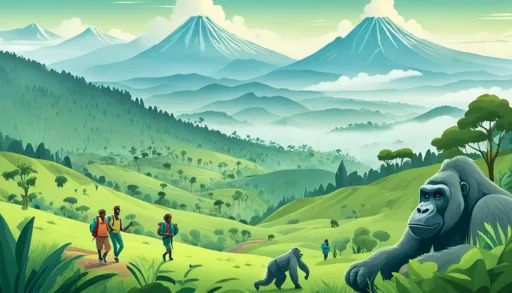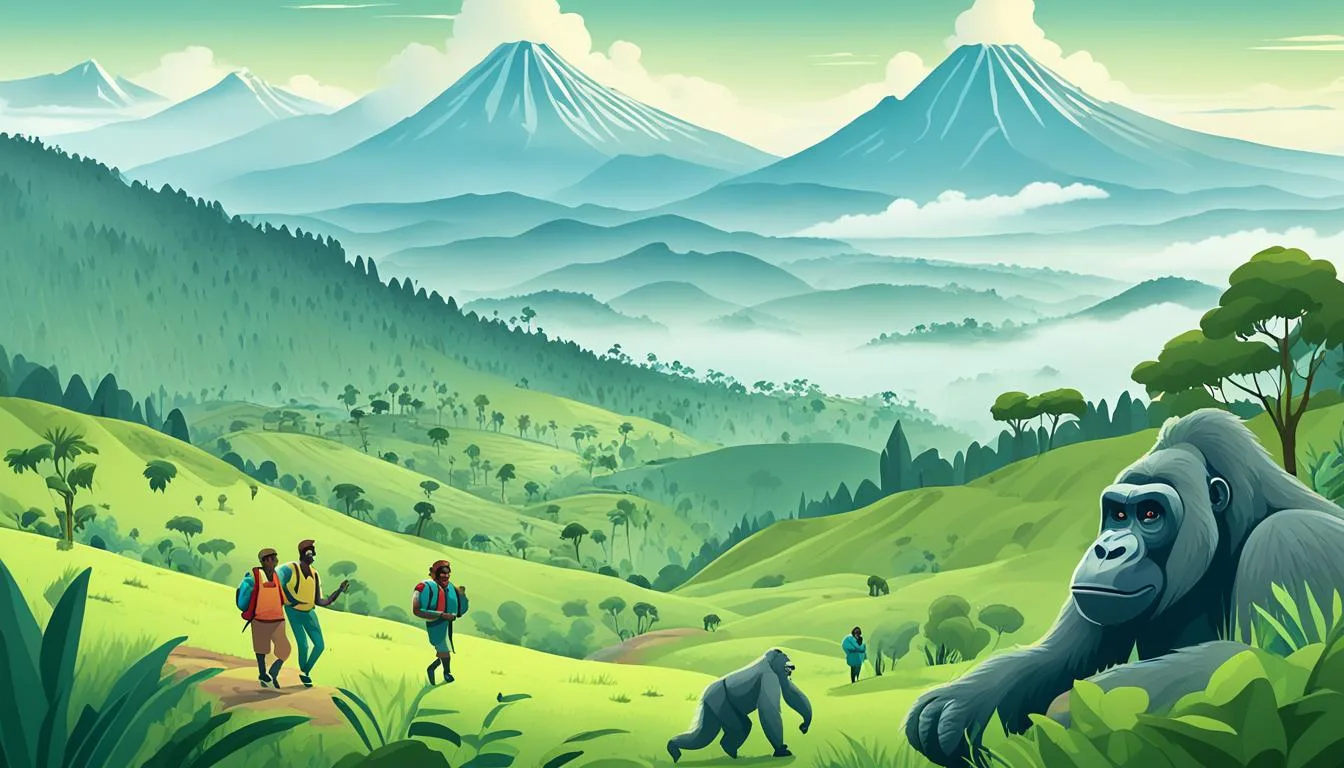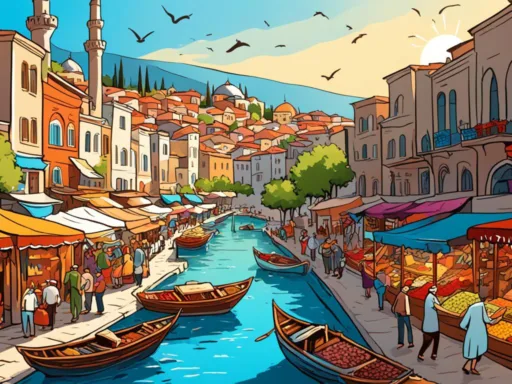Does the secret to the ultimate Rwandan adventure lie in timing your visit? Embarking on Rwanda trekking tours during the right Rwanda tourism season can enhance your experience beyond what you’ve imagined. Delving into unforgettable gorilla trekking journeys and enriching Rwandan cultural experiences requires insight into when the land of a thousand hills welcomes you with open arms. This essential Rwanda travel guide paints the vivid landscapes and vibrant traditions waiting to be explored, providing the invaluable “whens” and “hows” for your next sojourn.
Key Takeaways
- January and February offer warm days and cooler evenings, ideal for safaris but warrant advance bookings.
- The rainy season from March to May presents lush treks with essential rain gear and possibly available last-minute permits.
- Peak trekking season between June and September guarantees comfortable conditions and culturally rich events like the Kwita Izina Ceremony.
- Visiting during the short rains from October to December can be cost-effective and equally rewarding.
- Understanding the nuances of each season allows for a tailored itinerary that maximizes wildlife and cultural engagement in Rwanda.
Understanding Rwanda’s Climate and Tourism Seasons
When planning a visit to Rwanda, reaching for a comprehensive Rwanda weather guide and Rwanda trip planner is indispensable. The country’s Rwandan equatorial climate is uniquely moderated by altitude, offering visitors mild temperatures throughout the year. However, to discern the best time for Rwanda gorilla trekking, one must consider the intricate dance between weather and terrain.
The dry seasons, spanning June to September and December to February, signal the pinnacle of tourism season preferences for travelers seeking to navigate Rwanda’s natural splendor with relative ease. During these windows, trails are drier, inviting more stable hikes and lowering the risk of malaria – pivotal considerations for anyone intent on experiencing the majesty of Rwanda’s gorillas firsthand.
Conversely, the rainy seasons create a striking, verdant backdrop for the gorilla’s habitat, despite the frequent and potentially demanding rains from March to May and from October to November. These seasons allure those wishing to immerse themselves in a more secluded adventure, as they often coincide with a reduction in tourist volume.
| Season | Conditions | Travel Considerations |
|---|---|---|
| Long Dry (Jun – Sep) | Dryer trails, lower malaria risk | Peak season for gorilla trekking, advance booking recommended |
| Short Dry (Dec – Feb) | Comfortable hiking conditions | Popular period for safaris and wildlife tours |
| Long Rainy (Mar – May) | Lush landscapes, higher precipitation | Fewer tourists, potential for quieter treks |
| Short Rainy (Oct – Nov) | Periodic rain, vibrant scenery | Opportunities for lower travel expenses |
Whatever the preference or inclination, Rwanda’s remarkable climate accommodates the ambitions of all travelers. Remaining conscious of seasonal changes and their impacts can ensure your time spent in this breathtaking country aligns with your expectations of an unforgettable expedition.
Best Time to Visit Rwanda for Gorilla Trekking
Deciding when to go on a Rwanda safari can greatly influence the quality of your gorilla trekking experience. Understanding the characteristics of each season, the demands for permits, and the practical safari tips can help ensure your adventure is unforgettable. Let’s dive into these aspects to assist you in becoming the ultimate Rwanda vacation planner.

Advantages of the Dry Season (June to September and December to February)
Dry season trekking is preferred for its optimal hiking conditions, which offer clearer paths and reduced chances of encountering rain. During this period, you’re more likely to enjoy unobstructed views of Rwanda’s lush landscapes and its majestic gorillas, making for perfect photo opportunities. Moreover, with lower health risks such as malaria, it’s no wonder that this is a peak tourism season in Rwanda. Plan ahead as gorilla trekking permits and suitable accommodation are in high demand.
Considerations for the Rainy Season (March to May and October to November)
For those who don’t mind a bit of mud, the rainy seasons could be a hidden gem. This period brings with it not just rain, but life to Rwanda’s flora and fauna, painting the country in radiant greens. With fewer tourists, it offers more intimate encounters and is ideal for travelers keen on solitude and reflection. The gorilla trekking permits may also be easier to obtain, and accommodations may offer off-peak rates.
Peak Season Challenges and Booking Tips
The allure of the dry season’s optimal conditions means higher competition for gorilla trekking permits. With Rwanda’s commitment to gorilla conservation through controlled tourism, permits are limited. Therefore, it is imperative to secure these well in advance, especially if planning to travel during peak tourism seasons in Rwanda. Proactive planning works in your favor, not just for the permits but also for ensuring you have a wide selection of lodgings to choose from.
- Book gorilla permits months in advance to avoid disappointment.
- Choose lodging early to get the best rates and availability during peak seasons.
- Prepare for variable weather; even in the dry season, it’s advisable to pack rain gear.
- Check the health precautions and requirements such as vaccinations and malaria prevention.
To enhance your gorilla trekking experience, incorporate these Rwanda safari tips into your travel preparations. Whether traveling in the dry or rainy season, thoughtful planning can make all the difference in enjoying the natural wonders of Rwanda.
Navigating Rwanda’s Topography and Wildlife During Your Visit
Exploring the scenic beauty of Rwanda’s landscapes is an adventure in itself, but when coupled with the opportunity for Rwanda gorilla safaris, it becomes an unforgettable journey. The Volcanoes National Park is a sanctuary not only for the flora and fauna that call it home but also for travelers from across the globe seeking genuine mountain gorilla encounters. The park’s impressive array of five extinct and three active volcanoes plays host to this majestic wildlife.
To prepare adequately for Volcanoes National Park trekking, it’s important to consider both physical and logistical aspects. Altitudes in the park can range between 8,000 and 13,000 feet, making acclimatization key for anyone not used to such heights. Therefore, it’s imperative that trekkers come ready to face the physical demands of day-long hikes through tropical jungles, which are challenging yet incredibly rewarding experiences.
As part of your Rwanda travel advice, here are a few essentials to aid in your preparations:
- Pack rain gear and waterproof clothing, as rainforests are inherently wet environments.
- Bring along hiking boots with excellent grip for the occasionally slippery trails.
- Ensure your fitness level is such that it allows you to enjoy the trek without undue strain.
- Prep for variable weather conditions even during the drier seasons.
The drier seasons typically offer more accessible trails and increased chances for clear wildlife viewing. However, even during these times, the ecological diversity of Rwanda provides a moisture-rich environment that can be unpredictable.
“For anyone embarking on a journey through Rwanda in search of the mountain gorilla, the awe-inspiring interaction with these incredible beings in their natural habitat is an encounter that resonates for a lifetime.”
In conclusion, whether you’re an experienced trekker or a first-time safari-goer, the draw of Rwanda’s rich topography and the allure of coming face-to-face with mountain gorillas promises an exploration that is as deeply moving as it is visually spectacular.
Cultural Experiences: Festivals and Events in Rwanda
While the majestic mountain gorillas are often the main attraction for visitors to Rwanda, the nation’s vibrant cultural events offer equally enriching experiences that delve into the heart of its traditions and modern-day creativity. Celebrations and ceremonies throughout the year provide travelers with a unique insight into the cultural fabric of this dynamic country.

The Kwita Izina Ceremony in June: Celebrating Rwanda’s Gorillas
The revered Kwita Izina gorilla-naming ceremony, held each June, is a powerful manifestation of Rwanda’s commitment to conservation and the preservation of its natural heritage. This cultural phenomenon draws a global audience, uniting villagers, government officials, and international guests in a festive and meaningful tradition. Participants get the opportunity to name the new born gorillas, a practice that has contributed to raising awareness about the species’ plight and the importance of protecting these magnificent creatures.
The Rwanda Film Festival in September: A Medium for Storytelling
The lights dim and the stories unfold at the Rwanda Film Festival, a beacon for filmmakers and enthusiasts from around the world. Since September sees Kigali transform into a hub of cinematic excellence, festival-goers are treated to an array of films that reflect both local and global perspectives, including narratives that highlight Rwanda’s rich history and contemporary culture. It serves as a platform for Rwandan artists to narrate their stories and share their vision with an international audience.
Local Traditions and Cultural Tourism Beyond Gorillas
Beyond the silver screens and the mountain forest’s whispers, Rwanda’s local traditions paint a colorful picture of its diverse culture. From the intricate dance and drumming performances to the craftsmanship of weavers and potters, each aspect of Rwanda’s cultural expression offers deeper insight into the country’s soul. Through cultural tourism, visitors are invited to partake in these traditions, fostering a mutual respect and understanding that extends far beyond the bounds of typical tourism.
| Event | Month | Highlights | Cultural Significance |
|---|---|---|---|
| Kwita Izina Ceremony | June | Gorilla naming, Conservation awareness | Symbolizes Rwanda’s dedication to gorilla conservation and respect for wildlife. |
| Rwanda Film Festival | September | Screenings, Workshops, and Awards | Encourages artistic expression and international dialogue through film. |
| Traditional Festivities | Year-round | Dance, Music, Handicrafts | Immersion into Rwanda’s rich cultural heritage and local traditions. |
As travelers explore these facets of Rwandan festivals, they not only contribute to the local economy but also help in preserving the cultural experiences in Rwanda. Inviting a deeper connection with the country, these events and the exploration of Rwanda local traditions, such as the vibrant Kwibuka commemorations, form an integral part of the full Rwandan journey.
Conclusion
As we draw this ultimate Rwanda travel guide to a close, it’s clear that whether one is lured by the extraordinary experience of gorilla trekking or the rich tapestry of cultural festivities, Rwanda offers a tapestry of experiences bound to leave an indelible mark on any traveler. Visitors embarking on this unforgettable journey should give thought to all facets: the variable yet welcoming climate, the diverse trekking conditions tailored to each season, and a cornucopia of wildlife encounters that are the essence of Rwanda’s natural grandeur.
The endeavor of Planning your Rwanda Gorilla Tour isn’t merely about setting dates and destinations; it’s about immersing oneself in the memorable Rwandan adventures that arise from the nuanced combination of meticulously timed visits, understanding the ebb and flow of the tourism seasons, and syncing one’s travels with the rhythm of Rwanda’s cultural heartbeat. The colorful and profound resonances of Rwanda’s festivals—such as the Kwita Izina ceremony—offer a cultural depth that complements the raw natural thrill of spending time in the proximity of the great mountain gorillas.
In culmination, a trip to this enchanting land requires a proactive stance, ensuring gorilla trekking permits are secured and accommodations are booked well in advance, particularly during peak tourism periods. By doing so, travelers guarantee themselves a place in the heart of Rwanda’s majestic landscape. Should one seek an adventure that defies the ordinary, embarking on this journey promises an array of experiences that walk the line between the surreal and the sublime, encapsulating the soul of Africa in one fiercely preserved, incredibly beautiful, and welcoming country.
FAQ
What is the best time to visit Rwanda for gorilla trekking?
The best time for gorilla trekking in Rwanda is during the long dry season from June to September and the short dry spell from December to February, as these periods offer optimal hiking conditions with less rainfall, drier trails, and clearer visibility for wildlife encounters.
How does Rwanda’s climate affect tourism seasons?
Rwanda’s equatorial climate, with its tropical highland characteristics, leads to moderate temperatures year-round, shaping tourism seasons preferences. The dry seasons are popular for gorilla trekking, but the rainy seasons can offer verdant landscapes and fewer tourists, presenting a different appeal.
Are there any advantages to visiting Rwanda during the dry season?
Yes, the dry season offers advantages such as more accessible trails, pleasant weather, excellent conditions for wildlife photography, and a lower risk of malaria. However, it also comes with increased costs and requires early booking for accommodations and permits.
What should I consider if traveling to Rwanda during the rainy season?
While the rainy season can make trails slippery and trekking more challenging, it also brings lush landscapes and the chance to enjoy quieter excursions. It’s important to bring rain gear and be prepared for possible changes in trekking schedules due to weather.
What challenges might I face during peak tourism seasons in Rwanda, and how can I overcome them?
The main challenges during Rwanda’s peak tourism seasons include higher travel prices and the need for advanced booking for gorilla trekking permits and accommodations. To overcome these, plan ahead, book early, and be prepared for the increased demand.
How does Rwanda’s topography impact my gorilla trekking experience?
Rwanda’s varied topography, featuring rolling hills and mountainous terrains, especially in Volcanoes National Park, provides diverse trekking adventures. The altitude and demanding hikes require a good level of fitness and adequate preparation for the best experience.
What cultural experiences does Rwanda offer beyond gorilla trekking?
Rwanda hosts significant cultural events such as the Kwita Izina gorilla-naming ceremony in June and the Rwanda Film Festival in September, alongside other local traditions and commemorations. These cultural experiences provide an enriching complement to wildlife tourism.
When is the Kwita Izina Ceremony held, and what is its significance?
The Kwita Izina Ceremony takes place in June and is a significant cultural event where newly born gorillas are named. It highlights Rwanda’s conservation efforts and the importance of gorillas in the country’s cultural heritage.
Can I participate in any film or storytelling events during my visit to Rwanda?
Yes, the Rwanda Film Festival held in September offers an opportunity for visitors to engage with storytelling through local and international films, providing insight into Rwanda’s narrative expressions.
What should I keep in mind when planning my Rwanda gorilla tour?
When planning your Rwanda gorilla tour, consider the seasonal climate variations, secure your trekking permits well in advance, particularly during peak seasons, and incorporate cultural events into your itinerary for a more memorable experience.






